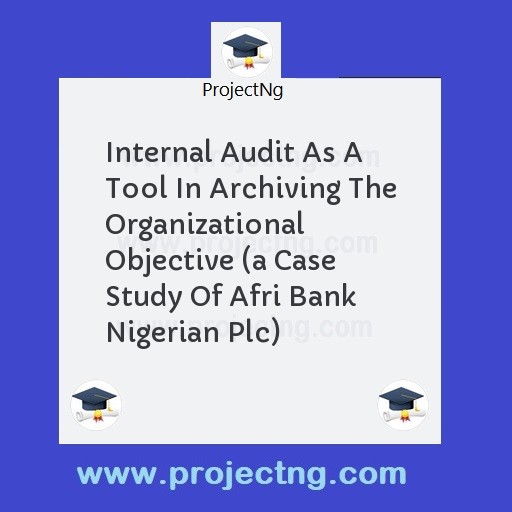Internal Audit As A Tool In Archiving The Organizational Objective (a Case Study Of Afri Bank Nigerian Plc)
Accounting Project Topics
Get the Complete Project Materials Now! »
INTERNAL AUDIT AS A TOOL IN ARCHIVING THE ORGANIZATIONAL OBJECTIVE (A CASE STUDY OF AFRI BANK NIGERIAN PLC)
ABSTRACT
The notion of the auditor being bound or a watchdog is gradually changing for the better as internal auditing has undergone tremendous changes in recent past.
The actual functions of the auditor is often surrounded in secrecy or held in some kind of awe.
Major notes of internal auditing have not been clear to the majority of people in the society. In view of numerous corrupt practice, frauds and embezzlement often uncovered by probe tool has often been questioned.
It is the realization of this that I have set out to look critically into internal audit department of Afribank with a view to finding whether effective internal auditing practices ensure effective control. The mode of appointment, independence and duties of the internal Auditor was looked into an determining whether the internal audit department is being operated as a management or efficiency audit.
The finding shows that internal auditor is not completely independent and mode of operation has a combination of characteristics of various types of auditing especially the operation type of audit.
Nevertheless a high degree of internal control exists in the bank. In consideration of improvement in some area, recommendations are proposed.
TABLE OF CONTENTS PAGES
Title page……………………………………………. I
Approval page……………………………………… ii
Dedication…………………………………………… iii
Acknowledgement………………………………… iv
Abstract……………………………………………….. V
Table of content……………………………………. Vi
CHAPTER ONE:
1.1 Introduction
1.2 Statement of problem
1.3 Purpose of study
1.4 Significant of study
1.5 Statement of hypotheses
1.6 Scope of the study
1.7 Limitation of the study
1.8 Definition of terms
CHAPTER TWO:
2.1 Review of related literature
2.2 Definition of internal audit
2.3 Function of internal audit
2.4 The basic of internal audit
2.5 Use of internal department
2.6 Effective area of internal audit
2.7 Limitation of internal audit department
2.8 The nature of accounting policy and computation
2.9 Role of audit in-banking nig plc.
CHAPTER THREE:
3.1 Research design and methodology
3.2 Selection of study area
3.3 Forms of collecting data
3.4 Problems encountered
3.5 Reliability
3.6 Validity
CHAPTER FOUR:
4.1 Data presentation and analysis
4.2 Data presentation and analysis
4.3 Test of hypothesis
CHAPTER FIVE:
5.1 Summery of findings, conclusion and
Recommendation
5.2 Findings
5.3 Conclusion
5.4 Recommendation
BIBLIOGRAPHY
APPENDIX: (QUESTIONAIRE)
CHAPTER ONE
1.1 INTRODUCTION
The system of controls adopted in any economy greatly determines the development and growth of that economy. To ensure optimization in money, materials machine, time, resource and management of men, controls are essentials.
These controls are installed by many organizations including banks to check how effective and efficient they maximize their resource. One of such controls commonly used to minimize wastage and guide plans to their eventual accomplishment is internal auditing. Auditing has been in existence for many years, it was in ancient Egypt and the great mercantile establishment of the middle ages. This shows that internal auditing can neither be neglected nor under rated in our modern economy for it was borne out of the complexities of modern business climate and transaction involved. In that other management of various large business organizations and government concern recognized internal auditing as a valuable machinery in achieving and objective deemed accurate at a given point in time.
The term “Audit” is from a Latin word “Audire” which means hr hears. This is because the account of an estate domain were checked by having them called out of those who complied them to those in authority. With the growth of trade and commerce the need for more accurate method of recording business activities arose. This, auditing is more a question of he hears but a whole process where by the books of account and vouchers of business entities (including charities, trusts) are subjected to critical examinations by professionally qualified and independent account (Auditors) on such a detail as will enable them from an option as to their truth and fairness. The Auditing is the bridge across the creditability gap created by the separation of management from ownership.
The complexity of the art of management extents to increasing ware of business fraud, embezzlement and the cash squeeze which often cripple many companies. The management has to look inward in order to uphold the space of activities and keep abreast with the changes in their immediate and external environment, and this can only be achieved a good and effective internal control system of which internal auditing is a major section. A writer maintained that the existence of an efficient and effective system of internal
Be the First to Share On Social

Enjoying our content?
Don't miss out on new videos! Subscribe to our YouTube channel for more awesome content.
Subscribe Now!













